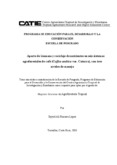| dc.description.abstract | En un ensayo experimental de sistemas agroforestales (SAF) de café (Coffea arabica variedad Caturra) en Turrialba, Costa Rica, se cuantificó el aporte de biomasa (MON) y el reciclaje de nutrientes (Ca, Mg, K, P y N) en 15 tratamientos con sombra de tres especies arbóreas, dos leguminosas (una de servicio y una maderable) y un árbol maderable no fijador de nitrógeno (Erythrina poeppigiana (poró), Chloroleucon eurycyclum (cashá) y Terminalia amazonia (roble coral)) solas y/o combinadas, bajo tres niveles de manejo (alto convencional (AC), medio convencional (MC) y alto orgánico (MO)). Con base en los índices de exportación, en general, los tratamientos bajo MO y los tratamientos asociados con leguminosas podrían soportar un periodo más prolongado para mantener la productividad del cultivo en caso de bajar o cesar la fertilización. Los valores de eficiencia de uso de nutrientes indicaron que los tratamientos orgánicos y los asociados con poró mostraron ser más efectivos para el reciclaje de nutrientes, lo que sugiere mayor disponibilidad de ellos para el cultivo. In an experiment of agroforestry systeMON (AF)S of coffee (Coffea Arabiga variety Caturra) in Turrialba, Costa Rica, the contribution of biomass was quantified (MON) and the recicling of nutrients (Ca, Mg, K, P and N) in 15 treatments with shade of three arboreal species, two leguminous and a timber species (Erythrina poeppigiana (poró), Chloroleucon eurycyclum (cashá) and Terminalia amazonia (coral oak)) single and/or combined, under three management levels (high conventional (AC), moderte conventional (MC) and high organic (MO)). When estimating the indexes of efficiency of the fertilization and of export of nutrients, it was found that in all the treatments, K was the element potentially limiting for the production of coffee and most exported. Based on the export indexes, the treatments under MO and the treatments associated with leguminous could better sustain the productivity of the crop in the event of lowering or ceasing fertilization. The efficiency of use of nutrients indicated that the organic treatments and those associated with poró were more effective for the recycling of nutrients, which should have greater availability for the coffee. | es_ES |


